Assignment 2: Pathophysiology and Pharmacology of Benji's Asthma
VerifiedAdded on 2022/09/06
|10
|3224
|17
Report
AI Summary
This report presents an in-depth analysis of an 11-year-old boy named Benji, who has a history of asthma. The report delves into the pathophysiology of asthma, exploring the inflammatory processes within the airways, the role of allergens, and the potential for both acute and late-onset responses. It examines three key symptoms: tracheal tug, tachycardia, and decreased oxygen saturation, linking them to the underlying mechanisms of Benji's condition. The report also details the pharmacology of the prescribed medications: salbutamol, ipratropium, and prednisolone, explaining their mechanisms of action in managing asthma symptoms and inflammation. The study also discusses the importance of these medications in treating asthma attacks, chronic obstructive pulmonary disease (COPD), and exercise-induced bronchoconstriction. The analysis highlights how these medications work to relax airway muscles, reduce inflammation, and improve breathing, providing a comprehensive understanding of Benji's treatment plan.

Running head: ASSIGNMENT 2: WRITTEN PAPER
ASSIGNMENT 2: WRITTEN PAPER
Name of the Student:
Name of the University:
Author’s Note:
ASSIGNMENT 2: WRITTEN PAPER
Name of the Student:
Name of the University:
Author’s Note:
Paraphrase This Document
Need a fresh take? Get an instant paraphrase of this document with our AI Paraphraser
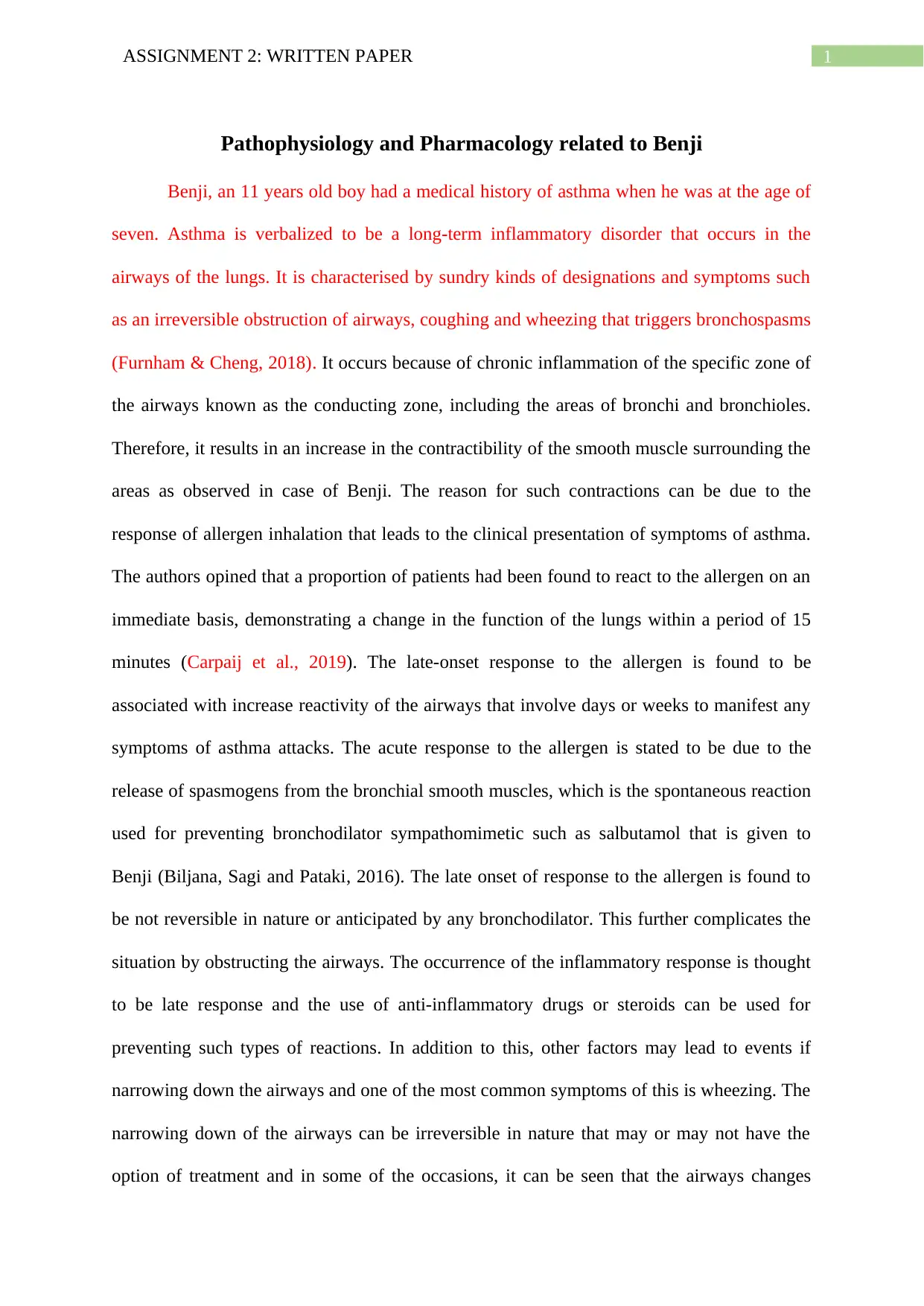
1ASSIGNMENT 2: WRITTEN PAPER
Pathophysiology and Pharmacology related to Benji
Benji, an 11 years old boy had a medical history of asthma when he was at the age of
seven. Asthma is verbalized to be a long-term inflammatory disorder that occurs in the
airways of the lungs. It is characterised by sundry kinds of designations and symptoms such
as an irreversible obstruction of airways, coughing and wheezing that triggers bronchospasms
(Furnham & Cheng, 2018). It occurs because of chronic inflammation of the specific zone of
the airways known as the conducting zone, including the areas of bronchi and bronchioles.
Therefore, it results in an increase in the contractibility of the smooth muscle surrounding the
areas as observed in case of Benji. The reason for such contractions can be due to the
response of allergen inhalation that leads to the clinical presentation of symptoms of asthma.
The authors opined that a proportion of patients had been found to react to the allergen on an
immediate basis, demonstrating a change in the function of the lungs within a period of 15
minutes (Carpaij et al., 2019). The late-onset response to the allergen is found to be
associated with increase reactivity of the airways that involve days or weeks to manifest any
symptoms of asthma attacks. The acute response to the allergen is stated to be due to the
release of spasmogens from the bronchial smooth muscles, which is the spontaneous reaction
used for preventing bronchodilator sympathomimetic such as salbutamol that is given to
Benji (Biljana, Sagi and Pataki, 2016). The late onset of response to the allergen is found to
be not reversible in nature or anticipated by any bronchodilator. This further complicates the
situation by obstructing the airways. The occurrence of the inflammatory response is thought
to be late response and the use of anti-inflammatory drugs or steroids can be used for
preventing such types of reactions. In addition to this, other factors may lead to events if
narrowing down the airways and one of the most common symptoms of this is wheezing. The
narrowing down of the airways can be irreversible in nature that may or may not have the
option of treatment and in some of the occasions, it can be seen that the airways changes
Pathophysiology and Pharmacology related to Benji
Benji, an 11 years old boy had a medical history of asthma when he was at the age of
seven. Asthma is verbalized to be a long-term inflammatory disorder that occurs in the
airways of the lungs. It is characterised by sundry kinds of designations and symptoms such
as an irreversible obstruction of airways, coughing and wheezing that triggers bronchospasms
(Furnham & Cheng, 2018). It occurs because of chronic inflammation of the specific zone of
the airways known as the conducting zone, including the areas of bronchi and bronchioles.
Therefore, it results in an increase in the contractibility of the smooth muscle surrounding the
areas as observed in case of Benji. The reason for such contractions can be due to the
response of allergen inhalation that leads to the clinical presentation of symptoms of asthma.
The authors opined that a proportion of patients had been found to react to the allergen on an
immediate basis, demonstrating a change in the function of the lungs within a period of 15
minutes (Carpaij et al., 2019). The late-onset response to the allergen is found to be
associated with increase reactivity of the airways that involve days or weeks to manifest any
symptoms of asthma attacks. The acute response to the allergen is stated to be due to the
release of spasmogens from the bronchial smooth muscles, which is the spontaneous reaction
used for preventing bronchodilator sympathomimetic such as salbutamol that is given to
Benji (Biljana, Sagi and Pataki, 2016). The late onset of response to the allergen is found to
be not reversible in nature or anticipated by any bronchodilator. This further complicates the
situation by obstructing the airways. The occurrence of the inflammatory response is thought
to be late response and the use of anti-inflammatory drugs or steroids can be used for
preventing such types of reactions. In addition to this, other factors may lead to events if
narrowing down the airways and one of the most common symptoms of this is wheezing. The
narrowing down of the airways can be irreversible in nature that may or may not have the
option of treatment and in some of the occasions, it can be seen that the airways changes
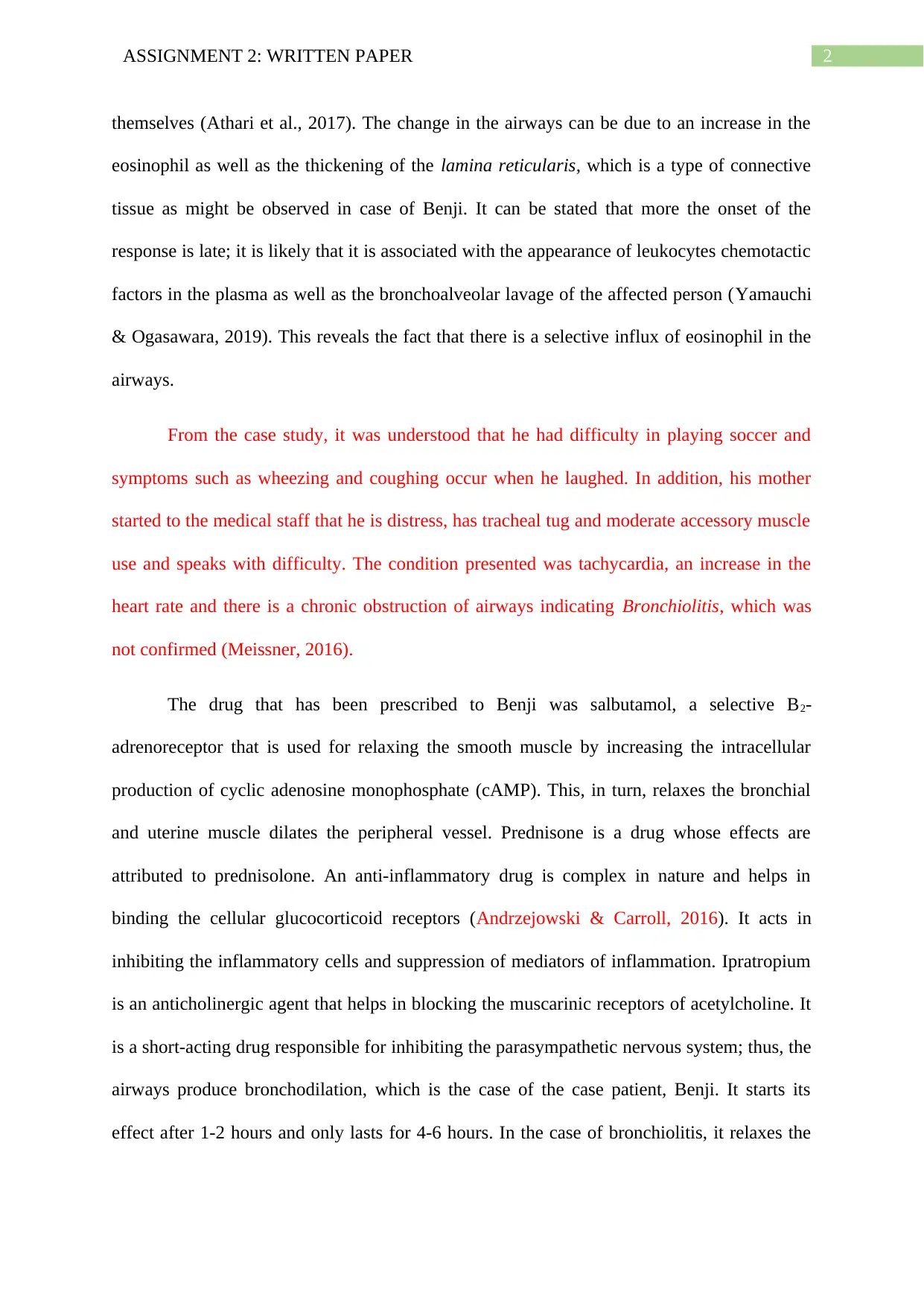
2ASSIGNMENT 2: WRITTEN PAPER
themselves (Athari et al., 2017). The change in the airways can be due to an increase in the
eosinophil as well as the thickening of the lamina reticularis, which is a type of connective
tissue as might be observed in case of Benji. It can be stated that more the onset of the
response is late; it is likely that it is associated with the appearance of leukocytes chemotactic
factors in the plasma as well as the bronchoalveolar lavage of the affected person (Yamauchi
& Ogasawara, 2019). This reveals the fact that there is a selective influx of eosinophil in the
airways.
From the case study, it was understood that he had difficulty in playing soccer and
symptoms such as wheezing and coughing occur when he laughed. In addition, his mother
started to the medical staff that he is distress, has tracheal tug and moderate accessory muscle
use and speaks with difficulty. The condition presented was tachycardia, an increase in the
heart rate and there is a chronic obstruction of airways indicating Bronchiolitis, which was
not confirmed (Meissner, 2016).
The drug that has been prescribed to Benji was salbutamol, a selective B2-
adrenoreceptor that is used for relaxing the smooth muscle by increasing the intracellular
production of cyclic adenosine monophosphate (cAMP). This, in turn, relaxes the bronchial
and uterine muscle dilates the peripheral vessel. Prednisone is a drug whose effects are
attributed to prednisolone. An anti-inflammatory drug is complex in nature and helps in
binding the cellular glucocorticoid receptors (Andrzejowski & Carroll, 2016). It acts in
inhibiting the inflammatory cells and suppression of mediators of inflammation. Ipratropium
is an anticholinergic agent that helps in blocking the muscarinic receptors of acetylcholine. It
is a short-acting drug responsible for inhibiting the parasympathetic nervous system; thus, the
airways produce bronchodilation, which is the case of the case patient, Benji. It starts its
effect after 1-2 hours and only lasts for 4-6 hours. In the case of bronchiolitis, it relaxes the
themselves (Athari et al., 2017). The change in the airways can be due to an increase in the
eosinophil as well as the thickening of the lamina reticularis, which is a type of connective
tissue as might be observed in case of Benji. It can be stated that more the onset of the
response is late; it is likely that it is associated with the appearance of leukocytes chemotactic
factors in the plasma as well as the bronchoalveolar lavage of the affected person (Yamauchi
& Ogasawara, 2019). This reveals the fact that there is a selective influx of eosinophil in the
airways.
From the case study, it was understood that he had difficulty in playing soccer and
symptoms such as wheezing and coughing occur when he laughed. In addition, his mother
started to the medical staff that he is distress, has tracheal tug and moderate accessory muscle
use and speaks with difficulty. The condition presented was tachycardia, an increase in the
heart rate and there is a chronic obstruction of airways indicating Bronchiolitis, which was
not confirmed (Meissner, 2016).
The drug that has been prescribed to Benji was salbutamol, a selective B2-
adrenoreceptor that is used for relaxing the smooth muscle by increasing the intracellular
production of cyclic adenosine monophosphate (cAMP). This, in turn, relaxes the bronchial
and uterine muscle dilates the peripheral vessel. Prednisone is a drug whose effects are
attributed to prednisolone. An anti-inflammatory drug is complex in nature and helps in
binding the cellular glucocorticoid receptors (Andrzejowski & Carroll, 2016). It acts in
inhibiting the inflammatory cells and suppression of mediators of inflammation. Ipratropium
is an anticholinergic agent that helps in blocking the muscarinic receptors of acetylcholine. It
is a short-acting drug responsible for inhibiting the parasympathetic nervous system; thus, the
airways produce bronchodilation, which is the case of the case patient, Benji. It starts its
effect after 1-2 hours and only lasts for 4-6 hours. In the case of bronchiolitis, it relaxes the
⊘ This is a preview!⊘
Do you want full access?
Subscribe today to unlock all pages.

Trusted by 1+ million students worldwide
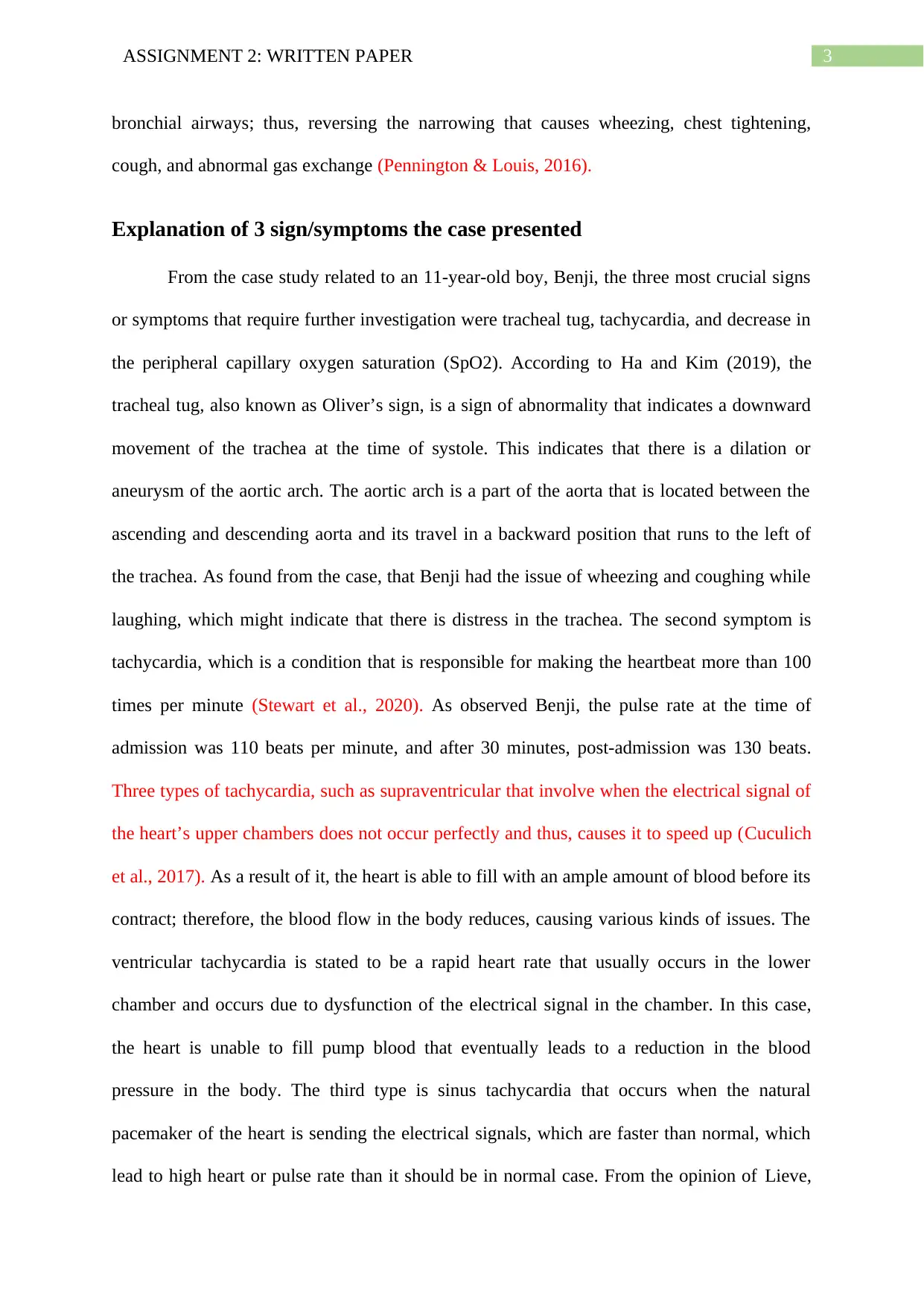
3ASSIGNMENT 2: WRITTEN PAPER
bronchial airways; thus, reversing the narrowing that causes wheezing, chest tightening,
cough, and abnormal gas exchange (Pennington & Louis, 2016).
Explanation of 3 sign/symptoms the case presented
From the case study related to an 11-year-old boy, Benji, the three most crucial signs
or symptoms that require further investigation were tracheal tug, tachycardia, and decrease in
the peripheral capillary oxygen saturation (SpO2). According to Ha and Kim (2019), the
tracheal tug, also known as Oliver’s sign, is a sign of abnormality that indicates a downward
movement of the trachea at the time of systole. This indicates that there is a dilation or
aneurysm of the aortic arch. The aortic arch is a part of the aorta that is located between the
ascending and descending aorta and its travel in a backward position that runs to the left of
the trachea. As found from the case, that Benji had the issue of wheezing and coughing while
laughing, which might indicate that there is distress in the trachea. The second symptom is
tachycardia, which is a condition that is responsible for making the heartbeat more than 100
times per minute (Stewart et al., 2020). As observed Benji, the pulse rate at the time of
admission was 110 beats per minute, and after 30 minutes, post-admission was 130 beats.
Three types of tachycardia, such as supraventricular that involve when the electrical signal of
the heart’s upper chambers does not occur perfectly and thus, causes it to speed up (Cuculich
et al., 2017). As a result of it, the heart is able to fill with an ample amount of blood before its
contract; therefore, the blood flow in the body reduces, causing various kinds of issues. The
ventricular tachycardia is stated to be a rapid heart rate that usually occurs in the lower
chamber and occurs due to dysfunction of the electrical signal in the chamber. In this case,
the heart is unable to fill pump blood that eventually leads to a reduction in the blood
pressure in the body. The third type is sinus tachycardia that occurs when the natural
pacemaker of the heart is sending the electrical signals, which are faster than normal, which
lead to high heart or pulse rate than it should be in normal case. From the opinion of Lieve,
bronchial airways; thus, reversing the narrowing that causes wheezing, chest tightening,
cough, and abnormal gas exchange (Pennington & Louis, 2016).
Explanation of 3 sign/symptoms the case presented
From the case study related to an 11-year-old boy, Benji, the three most crucial signs
or symptoms that require further investigation were tracheal tug, tachycardia, and decrease in
the peripheral capillary oxygen saturation (SpO2). According to Ha and Kim (2019), the
tracheal tug, also known as Oliver’s sign, is a sign of abnormality that indicates a downward
movement of the trachea at the time of systole. This indicates that there is a dilation or
aneurysm of the aortic arch. The aortic arch is a part of the aorta that is located between the
ascending and descending aorta and its travel in a backward position that runs to the left of
the trachea. As found from the case, that Benji had the issue of wheezing and coughing while
laughing, which might indicate that there is distress in the trachea. The second symptom is
tachycardia, which is a condition that is responsible for making the heartbeat more than 100
times per minute (Stewart et al., 2020). As observed Benji, the pulse rate at the time of
admission was 110 beats per minute, and after 30 minutes, post-admission was 130 beats.
Three types of tachycardia, such as supraventricular that involve when the electrical signal of
the heart’s upper chambers does not occur perfectly and thus, causes it to speed up (Cuculich
et al., 2017). As a result of it, the heart is able to fill with an ample amount of blood before its
contract; therefore, the blood flow in the body reduces, causing various kinds of issues. The
ventricular tachycardia is stated to be a rapid heart rate that usually occurs in the lower
chamber and occurs due to dysfunction of the electrical signal in the chamber. In this case,
the heart is unable to fill pump blood that eventually leads to a reduction in the blood
pressure in the body. The third type is sinus tachycardia that occurs when the natural
pacemaker of the heart is sending the electrical signals, which are faster than normal, which
lead to high heart or pulse rate than it should be in normal case. From the opinion of Lieve,
Paraphrase This Document
Need a fresh take? Get an instant paraphrase of this document with our AI Paraphraser
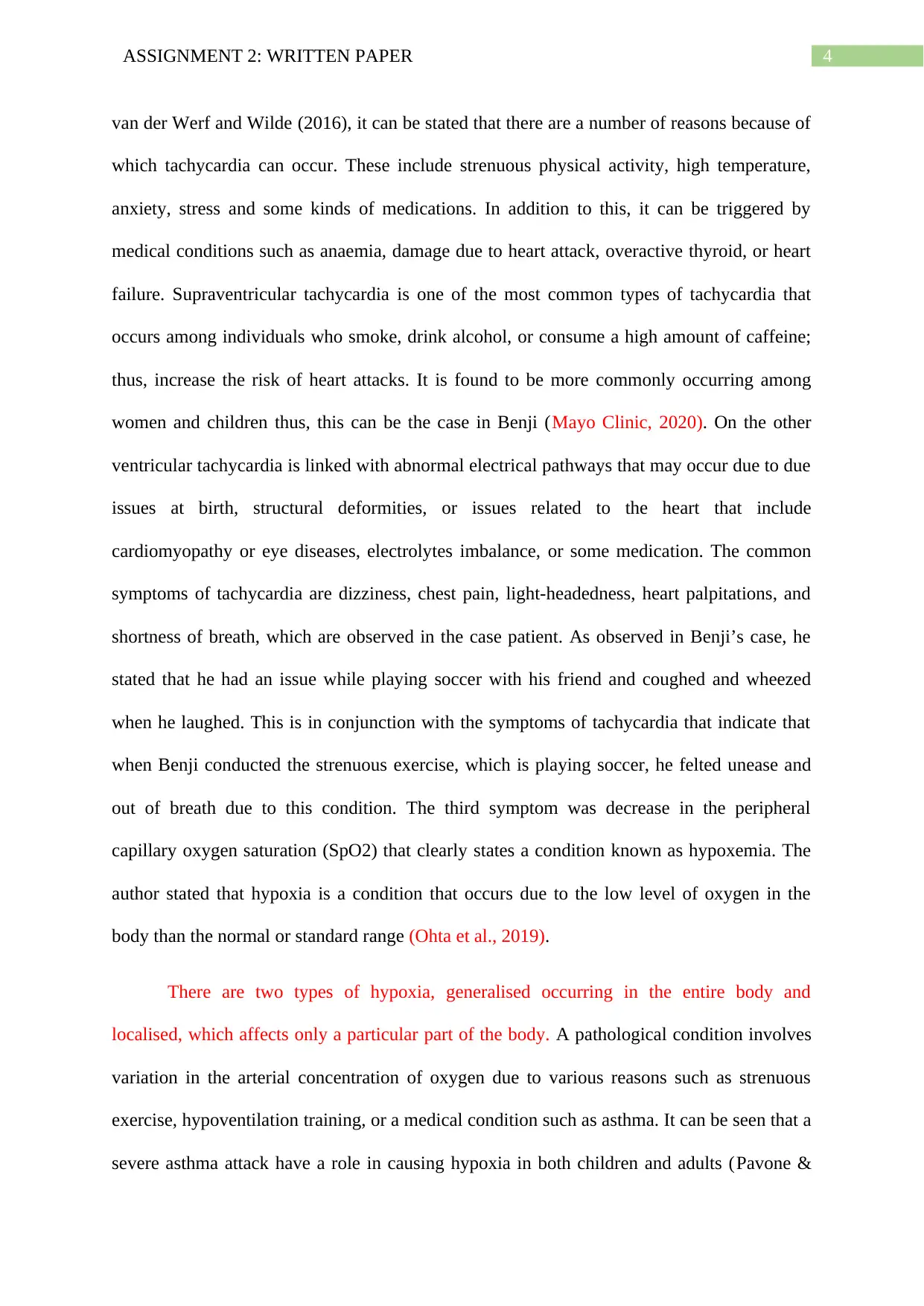
4ASSIGNMENT 2: WRITTEN PAPER
van der Werf and Wilde (2016), it can be stated that there are a number of reasons because of
which tachycardia can occur. These include strenuous physical activity, high temperature,
anxiety, stress and some kinds of medications. In addition to this, it can be triggered by
medical conditions such as anaemia, damage due to heart attack, overactive thyroid, or heart
failure. Supraventricular tachycardia is one of the most common types of tachycardia that
occurs among individuals who smoke, drink alcohol, or consume a high amount of caffeine;
thus, increase the risk of heart attacks. It is found to be more commonly occurring among
women and children thus, this can be the case in Benji (Mayo Clinic, 2020). On the other
ventricular tachycardia is linked with abnormal electrical pathways that may occur due to due
issues at birth, structural deformities, or issues related to the heart that include
cardiomyopathy or eye diseases, electrolytes imbalance, or some medication. The common
symptoms of tachycardia are dizziness, chest pain, light-headedness, heart palpitations, and
shortness of breath, which are observed in the case patient. As observed in Benji’s case, he
stated that he had an issue while playing soccer with his friend and coughed and wheezed
when he laughed. This is in conjunction with the symptoms of tachycardia that indicate that
when Benji conducted the strenuous exercise, which is playing soccer, he felted unease and
out of breath due to this condition. The third symptom was decrease in the peripheral
capillary oxygen saturation (SpO2) that clearly states a condition known as hypoxemia. The
author stated that hypoxia is a condition that occurs due to the low level of oxygen in the
body than the normal or standard range (Ohta et al., 2019).
There are two types of hypoxia, generalised occurring in the entire body and
localised, which affects only a particular part of the body. A pathological condition involves
variation in the arterial concentration of oxygen due to various reasons such as strenuous
exercise, hypoventilation training, or a medical condition such as asthma. It can be seen that a
severe asthma attack have a role in causing hypoxia in both children and adults (Pavone &
van der Werf and Wilde (2016), it can be stated that there are a number of reasons because of
which tachycardia can occur. These include strenuous physical activity, high temperature,
anxiety, stress and some kinds of medications. In addition to this, it can be triggered by
medical conditions such as anaemia, damage due to heart attack, overactive thyroid, or heart
failure. Supraventricular tachycardia is one of the most common types of tachycardia that
occurs among individuals who smoke, drink alcohol, or consume a high amount of caffeine;
thus, increase the risk of heart attacks. It is found to be more commonly occurring among
women and children thus, this can be the case in Benji (Mayo Clinic, 2020). On the other
ventricular tachycardia is linked with abnormal electrical pathways that may occur due to due
issues at birth, structural deformities, or issues related to the heart that include
cardiomyopathy or eye diseases, electrolytes imbalance, or some medication. The common
symptoms of tachycardia are dizziness, chest pain, light-headedness, heart palpitations, and
shortness of breath, which are observed in the case patient. As observed in Benji’s case, he
stated that he had an issue while playing soccer with his friend and coughed and wheezed
when he laughed. This is in conjunction with the symptoms of tachycardia that indicate that
when Benji conducted the strenuous exercise, which is playing soccer, he felted unease and
out of breath due to this condition. The third symptom was decrease in the peripheral
capillary oxygen saturation (SpO2) that clearly states a condition known as hypoxemia. The
author stated that hypoxia is a condition that occurs due to the low level of oxygen in the
body than the normal or standard range (Ohta et al., 2019).
There are two types of hypoxia, generalised occurring in the entire body and
localised, which affects only a particular part of the body. A pathological condition involves
variation in the arterial concentration of oxygen due to various reasons such as strenuous
exercise, hypoventilation training, or a medical condition such as asthma. It can be seen that a
severe asthma attack have a role in causing hypoxia in both children and adults (Pavone &
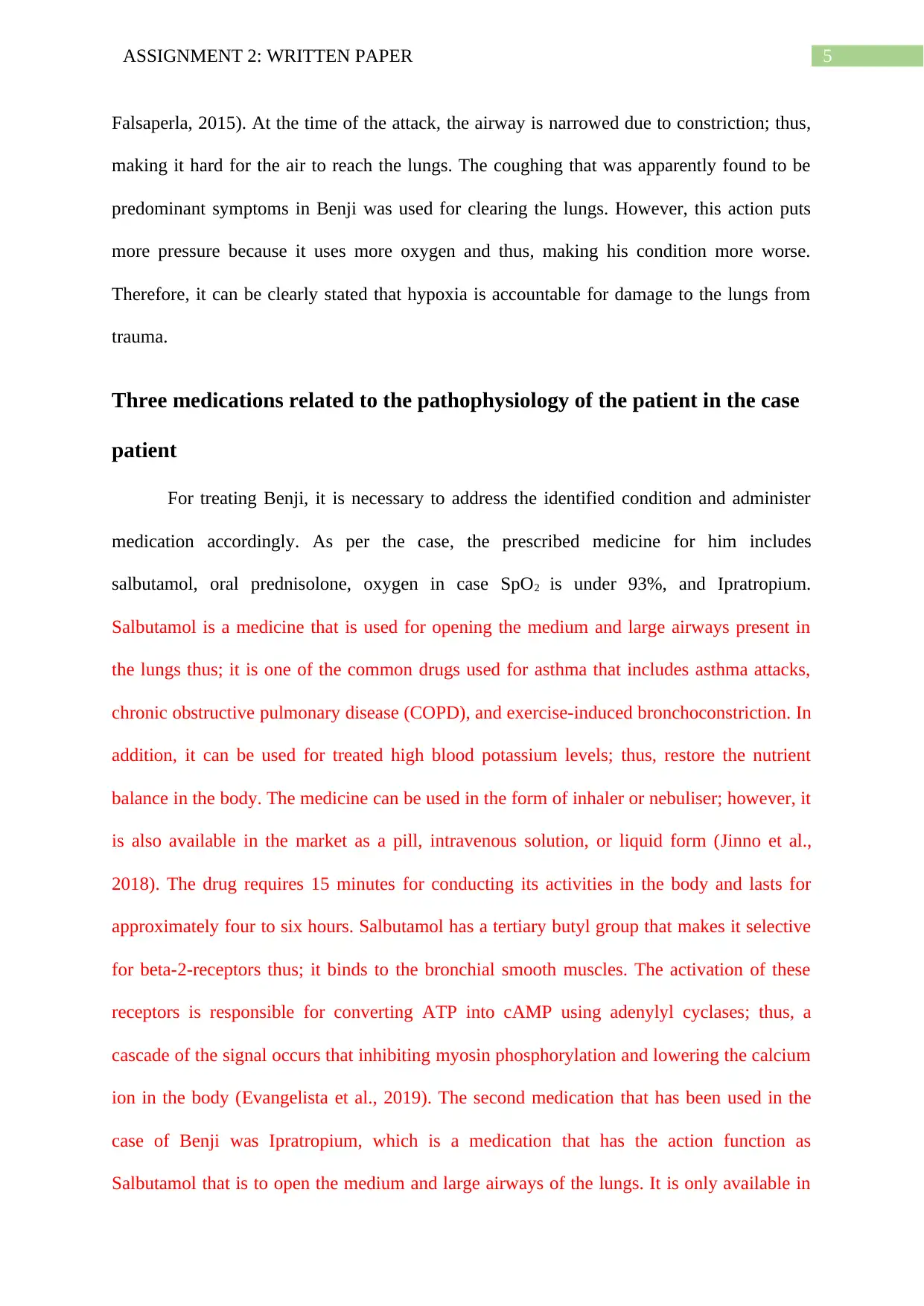
5ASSIGNMENT 2: WRITTEN PAPER
Falsaperla, 2015). At the time of the attack, the airway is narrowed due to constriction; thus,
making it hard for the air to reach the lungs. The coughing that was apparently found to be
predominant symptoms in Benji was used for clearing the lungs. However, this action puts
more pressure because it uses more oxygen and thus, making his condition more worse.
Therefore, it can be clearly stated that hypoxia is accountable for damage to the lungs from
trauma.
Three medications related to the pathophysiology of the patient in the case
patient
For treating Benji, it is necessary to address the identified condition and administer
medication accordingly. As per the case, the prescribed medicine for him includes
salbutamol, oral prednisolone, oxygen in case SpO2 is under 93%, and Ipratropium.
Salbutamol is a medicine that is used for opening the medium and large airways present in
the lungs thus; it is one of the common drugs used for asthma that includes asthma attacks,
chronic obstructive pulmonary disease (COPD), and exercise-induced bronchoconstriction. In
addition, it can be used for treated high blood potassium levels; thus, restore the nutrient
balance in the body. The medicine can be used in the form of inhaler or nebuliser; however, it
is also available in the market as a pill, intravenous solution, or liquid form (Jinno et al.,
2018). The drug requires 15 minutes for conducting its activities in the body and lasts for
approximately four to six hours. Salbutamol has a tertiary butyl group that makes it selective
for beta-2-receptors thus; it binds to the bronchial smooth muscles. The activation of these
receptors is responsible for converting ATP into cAMP using adenylyl cyclases; thus, a
cascade of the signal occurs that inhibiting myosin phosphorylation and lowering the calcium
ion in the body (Evangelista et al., 2019). The second medication that has been used in the
case of Benji was Ipratropium, which is a medication that has the action function as
Salbutamol that is to open the medium and large airways of the lungs. It is only available in
Falsaperla, 2015). At the time of the attack, the airway is narrowed due to constriction; thus,
making it hard for the air to reach the lungs. The coughing that was apparently found to be
predominant symptoms in Benji was used for clearing the lungs. However, this action puts
more pressure because it uses more oxygen and thus, making his condition more worse.
Therefore, it can be clearly stated that hypoxia is accountable for damage to the lungs from
trauma.
Three medications related to the pathophysiology of the patient in the case
patient
For treating Benji, it is necessary to address the identified condition and administer
medication accordingly. As per the case, the prescribed medicine for him includes
salbutamol, oral prednisolone, oxygen in case SpO2 is under 93%, and Ipratropium.
Salbutamol is a medicine that is used for opening the medium and large airways present in
the lungs thus; it is one of the common drugs used for asthma that includes asthma attacks,
chronic obstructive pulmonary disease (COPD), and exercise-induced bronchoconstriction. In
addition, it can be used for treated high blood potassium levels; thus, restore the nutrient
balance in the body. The medicine can be used in the form of inhaler or nebuliser; however, it
is also available in the market as a pill, intravenous solution, or liquid form (Jinno et al.,
2018). The drug requires 15 minutes for conducting its activities in the body and lasts for
approximately four to six hours. Salbutamol has a tertiary butyl group that makes it selective
for beta-2-receptors thus; it binds to the bronchial smooth muscles. The activation of these
receptors is responsible for converting ATP into cAMP using adenylyl cyclases; thus, a
cascade of the signal occurs that inhibiting myosin phosphorylation and lowering the calcium
ion in the body (Evangelista et al., 2019). The second medication that has been used in the
case of Benji was Ipratropium, which is a medication that has the action function as
Salbutamol that is to open the medium and large airways of the lungs. It is only available in
⊘ This is a preview!⊘
Do you want full access?
Subscribe today to unlock all pages.

Trusted by 1+ million students worldwide
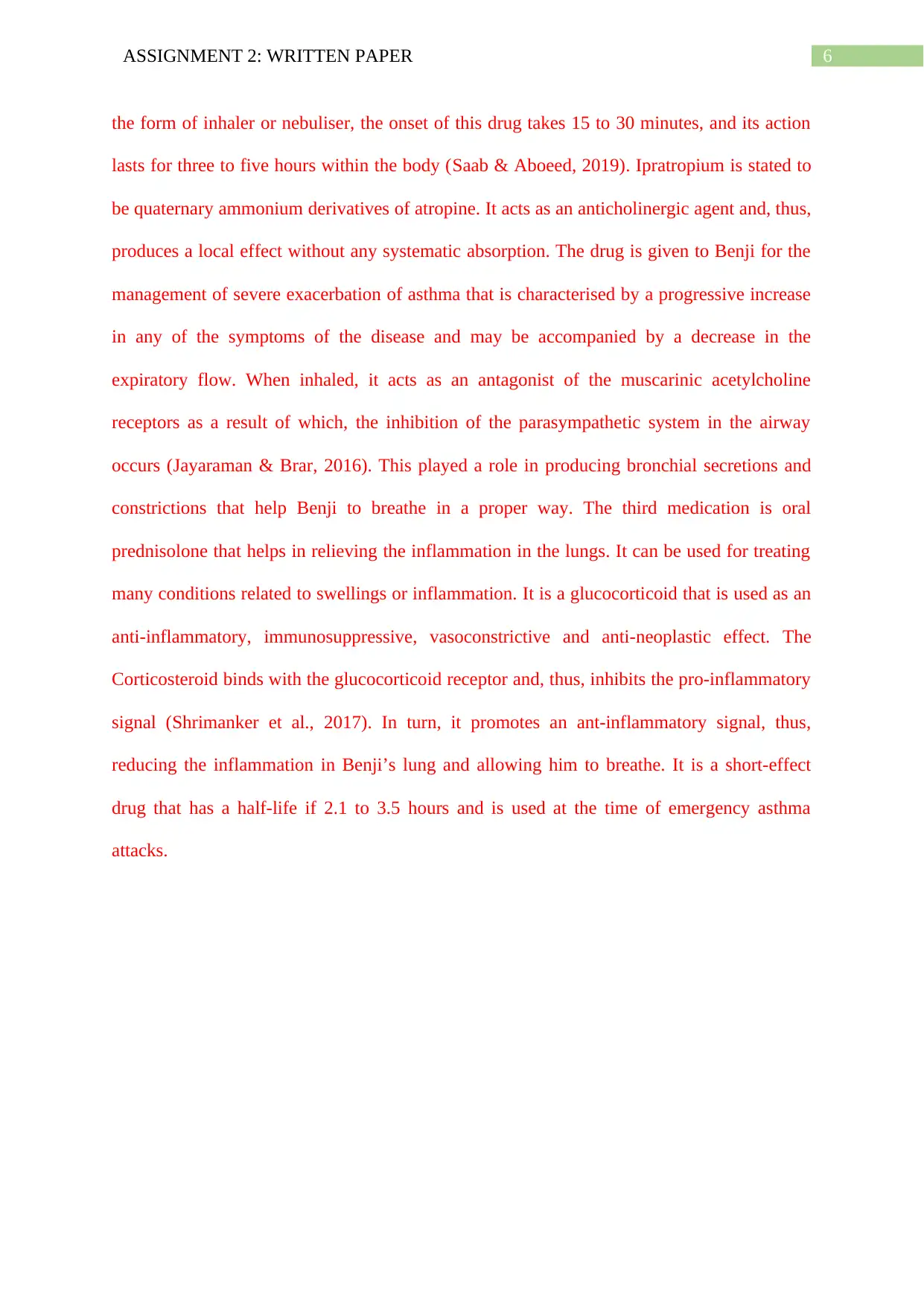
6ASSIGNMENT 2: WRITTEN PAPER
the form of inhaler or nebuliser, the onset of this drug takes 15 to 30 minutes, and its action
lasts for three to five hours within the body (Saab & Aboeed, 2019). Ipratropium is stated to
be quaternary ammonium derivatives of atropine. It acts as an anticholinergic agent and, thus,
produces a local effect without any systematic absorption. The drug is given to Benji for the
management of severe exacerbation of asthma that is characterised by a progressive increase
in any of the symptoms of the disease and may be accompanied by a decrease in the
expiratory flow. When inhaled, it acts as an antagonist of the muscarinic acetylcholine
receptors as a result of which, the inhibition of the parasympathetic system in the airway
occurs (Jayaraman & Brar, 2016). This played a role in producing bronchial secretions and
constrictions that help Benji to breathe in a proper way. The third medication is oral
prednisolone that helps in relieving the inflammation in the lungs. It can be used for treating
many conditions related to swellings or inflammation. It is a glucocorticoid that is used as an
anti-inflammatory, immunosuppressive, vasoconstrictive and anti-neoplastic effect. The
Corticosteroid binds with the glucocorticoid receptor and, thus, inhibits the pro-inflammatory
signal (Shrimanker et al., 2017). In turn, it promotes an ant-inflammatory signal, thus,
reducing the inflammation in Benji’s lung and allowing him to breathe. It is a short-effect
drug that has a half-life if 2.1 to 3.5 hours and is used at the time of emergency asthma
attacks.
the form of inhaler or nebuliser, the onset of this drug takes 15 to 30 minutes, and its action
lasts for three to five hours within the body (Saab & Aboeed, 2019). Ipratropium is stated to
be quaternary ammonium derivatives of atropine. It acts as an anticholinergic agent and, thus,
produces a local effect without any systematic absorption. The drug is given to Benji for the
management of severe exacerbation of asthma that is characterised by a progressive increase
in any of the symptoms of the disease and may be accompanied by a decrease in the
expiratory flow. When inhaled, it acts as an antagonist of the muscarinic acetylcholine
receptors as a result of which, the inhibition of the parasympathetic system in the airway
occurs (Jayaraman & Brar, 2016). This played a role in producing bronchial secretions and
constrictions that help Benji to breathe in a proper way. The third medication is oral
prednisolone that helps in relieving the inflammation in the lungs. It can be used for treating
many conditions related to swellings or inflammation. It is a glucocorticoid that is used as an
anti-inflammatory, immunosuppressive, vasoconstrictive and anti-neoplastic effect. The
Corticosteroid binds with the glucocorticoid receptor and, thus, inhibits the pro-inflammatory
signal (Shrimanker et al., 2017). In turn, it promotes an ant-inflammatory signal, thus,
reducing the inflammation in Benji’s lung and allowing him to breathe. It is a short-effect
drug that has a half-life if 2.1 to 3.5 hours and is used at the time of emergency asthma
attacks.
Paraphrase This Document
Need a fresh take? Get an instant paraphrase of this document with our AI Paraphraser
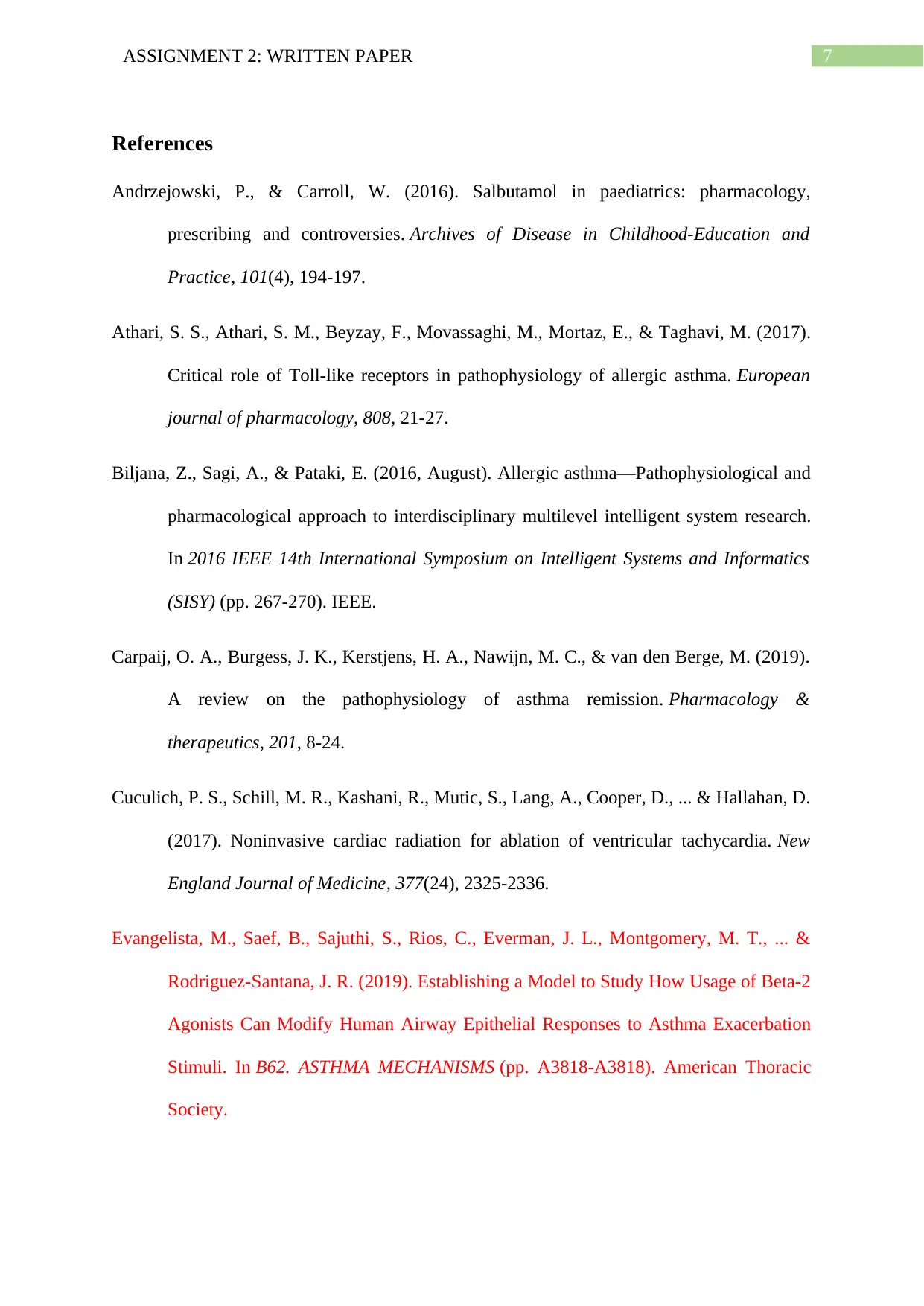
7ASSIGNMENT 2: WRITTEN PAPER
References
Andrzejowski, P., & Carroll, W. (2016). Salbutamol in paediatrics: pharmacology,
prescribing and controversies. Archives of Disease in Childhood-Education and
Practice, 101(4), 194-197.
Athari, S. S., Athari, S. M., Beyzay, F., Movassaghi, M., Mortaz, E., & Taghavi, M. (2017).
Critical role of Toll-like receptors in pathophysiology of allergic asthma. European
journal of pharmacology, 808, 21-27.
Biljana, Z., Sagi, A., & Pataki, E. (2016, August). Allergic asthma—Pathophysiological and
pharmacological approach to interdisciplinary multilevel intelligent system research.
In 2016 IEEE 14th International Symposium on Intelligent Systems and Informatics
(SISY) (pp. 267-270). IEEE.
Carpaij, O. A., Burgess, J. K., Kerstjens, H. A., Nawijn, M. C., & van den Berge, M. (2019).
A review on the pathophysiology of asthma remission. Pharmacology &
therapeutics, 201, 8-24.
Cuculich, P. S., Schill, M. R., Kashani, R., Mutic, S., Lang, A., Cooper, D., ... & Hallahan, D.
(2017). Noninvasive cardiac radiation for ablation of ventricular tachycardia. New
England Journal of Medicine, 377(24), 2325-2336.
Evangelista, M., Saef, B., Sajuthi, S., Rios, C., Everman, J. L., Montgomery, M. T., ... &
Rodriguez-Santana, J. R. (2019). Establishing a Model to Study How Usage of Beta-2
Agonists Can Modify Human Airway Epithelial Responses to Asthma Exacerbation
Stimuli. In B62. ASTHMA MECHANISMS (pp. A3818-A3818). American Thoracic
Society.
References
Andrzejowski, P., & Carroll, W. (2016). Salbutamol in paediatrics: pharmacology,
prescribing and controversies. Archives of Disease in Childhood-Education and
Practice, 101(4), 194-197.
Athari, S. S., Athari, S. M., Beyzay, F., Movassaghi, M., Mortaz, E., & Taghavi, M. (2017).
Critical role of Toll-like receptors in pathophysiology of allergic asthma. European
journal of pharmacology, 808, 21-27.
Biljana, Z., Sagi, A., & Pataki, E. (2016, August). Allergic asthma—Pathophysiological and
pharmacological approach to interdisciplinary multilevel intelligent system research.
In 2016 IEEE 14th International Symposium on Intelligent Systems and Informatics
(SISY) (pp. 267-270). IEEE.
Carpaij, O. A., Burgess, J. K., Kerstjens, H. A., Nawijn, M. C., & van den Berge, M. (2019).
A review on the pathophysiology of asthma remission. Pharmacology &
therapeutics, 201, 8-24.
Cuculich, P. S., Schill, M. R., Kashani, R., Mutic, S., Lang, A., Cooper, D., ... & Hallahan, D.
(2017). Noninvasive cardiac radiation for ablation of ventricular tachycardia. New
England Journal of Medicine, 377(24), 2325-2336.
Evangelista, M., Saef, B., Sajuthi, S., Rios, C., Everman, J. L., Montgomery, M. T., ... &
Rodriguez-Santana, J. R. (2019). Establishing a Model to Study How Usage of Beta-2
Agonists Can Modify Human Airway Epithelial Responses to Asthma Exacerbation
Stimuli. In B62. ASTHMA MECHANISMS (pp. A3818-A3818). American Thoracic
Society.
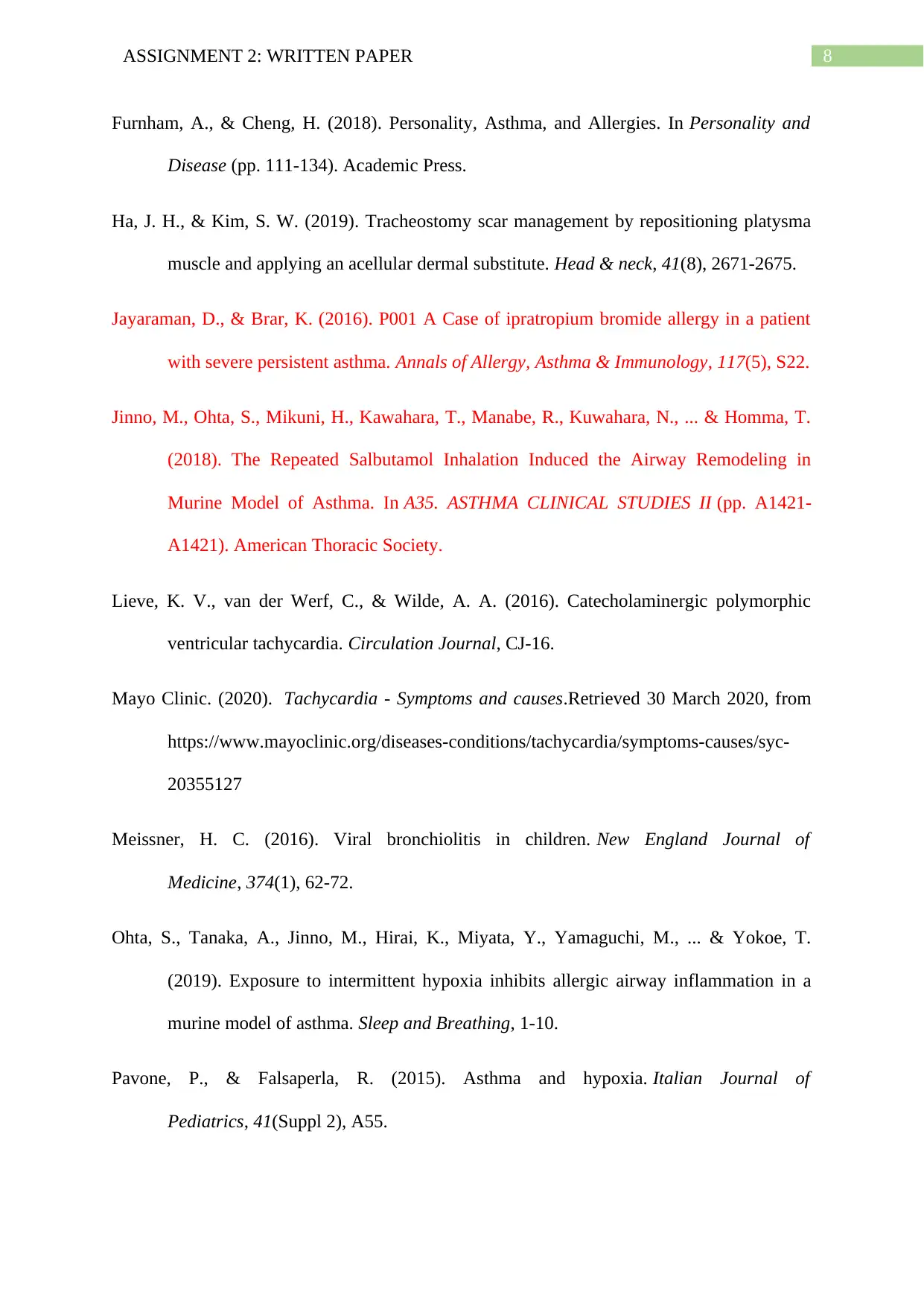
8ASSIGNMENT 2: WRITTEN PAPER
Furnham, A., & Cheng, H. (2018). Personality, Asthma, and Allergies. In Personality and
Disease (pp. 111-134). Academic Press.
Ha, J. H., & Kim, S. W. (2019). Tracheostomy scar management by repositioning platysma
muscle and applying an acellular dermal substitute. Head & neck, 41(8), 2671-2675.
Jayaraman, D., & Brar, K. (2016). P001 A Case of ipratropium bromide allergy in a patient
with severe persistent asthma. Annals of Allergy, Asthma & Immunology, 117(5), S22.
Jinno, M., Ohta, S., Mikuni, H., Kawahara, T., Manabe, R., Kuwahara, N., ... & Homma, T.
(2018). The Repeated Salbutamol Inhalation Induced the Airway Remodeling in
Murine Model of Asthma. In A35. ASTHMA CLINICAL STUDIES II (pp. A1421-
A1421). American Thoracic Society.
Lieve, K. V., van der Werf, C., & Wilde, A. A. (2016). Catecholaminergic polymorphic
ventricular tachycardia. Circulation Journal, CJ-16.
Mayo Clinic. (2020). Tachycardia - Symptoms and causes.Retrieved 30 March 2020, from
https://www.mayoclinic.org/diseases-conditions/tachycardia/symptoms-causes/syc-
20355127
Meissner, H. C. (2016). Viral bronchiolitis in children. New England Journal of
Medicine, 374(1), 62-72.
Ohta, S., Tanaka, A., Jinno, M., Hirai, K., Miyata, Y., Yamaguchi, M., ... & Yokoe, T.
(2019). Exposure to intermittent hypoxia inhibits allergic airway inflammation in a
murine model of asthma. Sleep and Breathing, 1-10.
Pavone, P., & Falsaperla, R. (2015). Asthma and hypoxia. Italian Journal of
Pediatrics, 41(Suppl 2), A55.
Furnham, A., & Cheng, H. (2018). Personality, Asthma, and Allergies. In Personality and
Disease (pp. 111-134). Academic Press.
Ha, J. H., & Kim, S. W. (2019). Tracheostomy scar management by repositioning platysma
muscle and applying an acellular dermal substitute. Head & neck, 41(8), 2671-2675.
Jayaraman, D., & Brar, K. (2016). P001 A Case of ipratropium bromide allergy in a patient
with severe persistent asthma. Annals of Allergy, Asthma & Immunology, 117(5), S22.
Jinno, M., Ohta, S., Mikuni, H., Kawahara, T., Manabe, R., Kuwahara, N., ... & Homma, T.
(2018). The Repeated Salbutamol Inhalation Induced the Airway Remodeling in
Murine Model of Asthma. In A35. ASTHMA CLINICAL STUDIES II (pp. A1421-
A1421). American Thoracic Society.
Lieve, K. V., van der Werf, C., & Wilde, A. A. (2016). Catecholaminergic polymorphic
ventricular tachycardia. Circulation Journal, CJ-16.
Mayo Clinic. (2020). Tachycardia - Symptoms and causes.Retrieved 30 March 2020, from
https://www.mayoclinic.org/diseases-conditions/tachycardia/symptoms-causes/syc-
20355127
Meissner, H. C. (2016). Viral bronchiolitis in children. New England Journal of
Medicine, 374(1), 62-72.
Ohta, S., Tanaka, A., Jinno, M., Hirai, K., Miyata, Y., Yamaguchi, M., ... & Yokoe, T.
(2019). Exposure to intermittent hypoxia inhibits allergic airway inflammation in a
murine model of asthma. Sleep and Breathing, 1-10.
Pavone, P., & Falsaperla, R. (2015). Asthma and hypoxia. Italian Journal of
Pediatrics, 41(Suppl 2), A55.
⊘ This is a preview!⊘
Do you want full access?
Subscribe today to unlock all pages.

Trusted by 1+ million students worldwide

9ASSIGNMENT 2: WRITTEN PAPER
Pennington, K. M., & Louis, E. K. S. (2016). “Don't Believe Your Eyes” Ipratropium
Induced Mydriasis: A Case Report and Review of the Literature. General medicine
(Los Angeles, Calif.), 4(3).
Saab, H., & Aboeed, A. (2019). Ipratropium. In StatPearls [Internet]. StatPearls Publishing.
Shrimanker, R., Hargaden, B., Bradding, P., Wardlaw, A. J., Brightling, C. E., Green, R., ...
& Haldar, P. (2017). Mepolizumab and the response to oral prednisolone in patients
with severe eosinophilic asthma.
Stewart, J. M., Medow, M. S., Visintainer, P., & Sutton, R. (2020). When Sinus Tachycardia
Becomes Too Much: Negative Effects of Excessive Upright Tachycardia on Cardiac
Output in Vasovagal Syncope, Postural Tachycardia Syndrome, and Inappropriate
Sinus Tachycardia. Circulation: Arrhythmia and Electrophysiology.
Yamauchi, K., & Ogasawara, M. (2019). The Role of Histamine in the Pathophysiology of
Asthma and the Clinical Efficacy of Antihistamines in Asthma Therapy. International
journal of molecular sciences, 20(7), 1733.
Pennington, K. M., & Louis, E. K. S. (2016). “Don't Believe Your Eyes” Ipratropium
Induced Mydriasis: A Case Report and Review of the Literature. General medicine
(Los Angeles, Calif.), 4(3).
Saab, H., & Aboeed, A. (2019). Ipratropium. In StatPearls [Internet]. StatPearls Publishing.
Shrimanker, R., Hargaden, B., Bradding, P., Wardlaw, A. J., Brightling, C. E., Green, R., ...
& Haldar, P. (2017). Mepolizumab and the response to oral prednisolone in patients
with severe eosinophilic asthma.
Stewart, J. M., Medow, M. S., Visintainer, P., & Sutton, R. (2020). When Sinus Tachycardia
Becomes Too Much: Negative Effects of Excessive Upright Tachycardia on Cardiac
Output in Vasovagal Syncope, Postural Tachycardia Syndrome, and Inappropriate
Sinus Tachycardia. Circulation: Arrhythmia and Electrophysiology.
Yamauchi, K., & Ogasawara, M. (2019). The Role of Histamine in the Pathophysiology of
Asthma and the Clinical Efficacy of Antihistamines in Asthma Therapy. International
journal of molecular sciences, 20(7), 1733.
1 out of 10
Related Documents
Your All-in-One AI-Powered Toolkit for Academic Success.
+13062052269
info@desklib.com
Available 24*7 on WhatsApp / Email
![[object Object]](/_next/static/media/star-bottom.7253800d.svg)
Unlock your academic potential
Copyright © 2020–2025 A2Z Services. All Rights Reserved. Developed and managed by ZUCOL.





